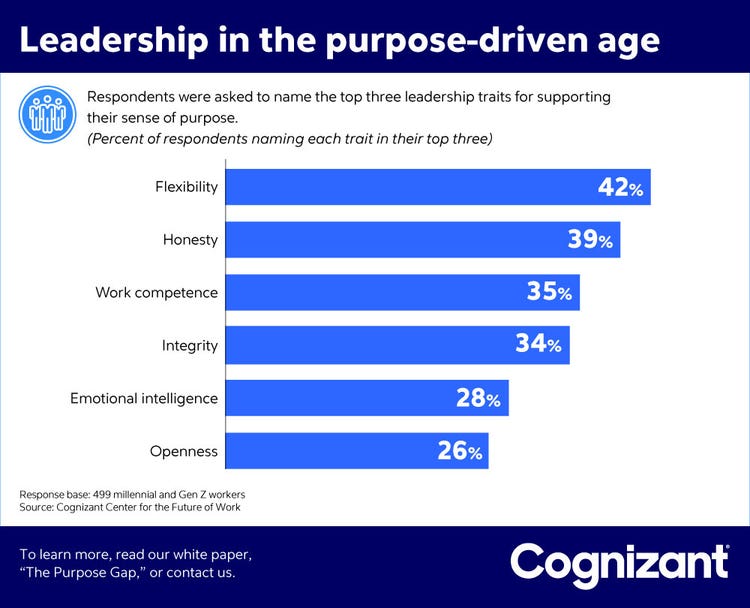
Closing the purpose gap styles-h2 text-white
data-xy-axis-lg:null; data-xy-axis-md:null; data-xy-axis-sm:75% 40%
<p><span class="medium"><br>March 04, 2022</span></p>
Closing the purpose gap
<p><b>When it comes to an enriching professional life, younger workers have expectations that businesses have trouble understanding, let alone meeting. We explain how employers can cater to workers who want their efforts to matter in a broader social sense.</b></p>
<p>As millennials and members of Gen Z entered the workforce, the relationship between “purpose” and “work” has become an important theme for organizations seeking to hire and retain the best. Purpose may be an overused and loosely defined term, but in the context of work, it encompasses all the values that drive people’s choices, actions and attitudes — from wider social and environmental goals, to professional and personal objectives such as a healthy work-life balance.</p> <p>Helping employees fulfill their purpose at work, while more important than ever, remains a highly elusive endeavor. In late 2021, we conducted a study to explore the purposes that motivate younger generations of workers, and the extent to which employers are delivering purposeful experiences. The picture that emerged should spur business leaders to reexamine their playbooks.</p> <p>With no end in sight to growing expectations for purpose at work, our research revealed steps businesses can take to close the existing gap.</p> <h5><i><b>1.</b></i> Get your internal communications right</h5> <p>Our study makes it clear that employees are often unaware of their employer’s efforts in many areas of purpose. For example, more than one in five respondents couldn’t say whether their organization’s performance metrics were aligned with its vision and values; a similar number said they didn’t understand their company’s mission, while more than one in four weren’t sure whether a realistic long-term plan was in place to achieve carbon neutrality. </p> <p>It’s hard to overstate the negative effects of such a lack of employee knowledge. Employees who don’t have a holistic picture of the business they work for will ultimately feel disengaged and struggle to think strategically about the opportunities and challenges the business faces. Further, they’ll fail to see the company’s wider purpose beyond the bottom line and even how their job can help them fulfill their personal purposes.</p> <p>Companies developing a communication strategy to close the purpose gap must start by asking themselves, “What don’t our young workers understand about our corporate purpose?” and “What don’t we understand about their personal purpose?” In addition, they must do the following:</p> <ul> <li><b>Involve managers in internal communications.</b> In most circumstances, one-size-fits-all communication is ineffective and can even be counterproductive. Effective communication depends on the right message reaching the right person at the right time. Managers are the ideal people to do this because no one else knows the members of their team so well. Never has this been more important than in an age of hybrid work, when face-to-face meetings are less frequent. Companies must train managers to identify and apply the best-suited communication methods for each circumstance. Our survey showed that 58% of young workers see frequent communication on the consequences of decisions and actions as one of the most important approaches to communication.<br> <br> </li> <li><b>Use tech wisely.</b> Companies must use tech with care if they want it to fulfill its role of ensuring young workers understand where corporations stand, in terms of purpose and in other areas. Sixty-three percent of respondents agree that excessive connectivity renders their attention too divided. So it’s vital not to over-index on digital communications to convey messaging on corporate purpose. Moreover, as anyone at the receiving end of an overwhelming volume of emails and other kinds of messages can attest, sometimes the best way to ensure a message goes unheard is to hide it in plain sight.</li> </ul> <h5><i><b>2.</b> </i> Empower young workers to fulfill their personal purposes</h5> <p>The age of micromanagement is dead, or should be. Young employees will not achieve the purposeful work they crave — including their highest personal priorities of finding passion for what they do and having a healthy work-life balance — if they are constantly monitored on what they do and how they do it.</p> <p>In a hybrid workplace, micromanagement can take an even greater toll on workers, prompting the feeling they are not trusted. Conversely, empowering team members with more autonomy to achieve business goals and contribute their ideas on a range of business-related areas will increase worker satisfaction, creativity and productivity.</p> <p>Other guidelines for businesses to follow include:</p> <ul> <li><b>Empowerment and guidance go hand-in-hand.</b> Empowering employees means giving them accountability for their own performance. Our conversations with young workers indicate they don’t want to avoid responsibility for their work outcomes; they just reject the notion of being told what to do every step of the way. What empowerment doesn’t mean, however, is leaving employees unsupported, especially when they are just starting their work lives or employment, or are facing a tricky situation.<br> <br> </li> <li><b>Help people understand how they can build a career in the company.</b> Guidance is necessary not only in individual projects and tasks; it’s equally important when it comes to their careers. A lack of clear, well-communicated growth paths can deprive companies of a strong pipeline of future leaders and put them in a position of constantly waiting for new senior hires to get up to speed. If companies want to retain their best talent — saving money and increasing broader job satisfaction in the process — they must ensure their young workers understand how they can fulfill their personal purposes. Relevant learning and development opportunities are important, but often insufficient.</li> </ul> <h5><b><i>3</i>.</b> Modernize your current leadership</h5> <p>Business leaders might initially believe it’s up to HR or the communications department to ensure younger employees understand the corporate purpose and the extent to which they’re able to live out their own personal purpose at work. But leadership must be at the heart of this effort, for two reasons. First, young workers are skeptical of the authenticity of their employer’s commitment to stated social and environmental goals.</p> <p>Second, it’s up to leaders to make decisions in areas such as remote work and promotion policies that will ultimately allow young workers to fulfill their individual purposes at work. When creating these policies, leaders must have a profound understanding of the changing dynamics that affect the work and personal lives of their younger colleagues.</p> <p>When we asked our respondents to identify the leadership traits that mattered most to them, flexibility came out on top, even above traditional (and still essential) characteristics, such as honesty and work competence.<br> </p>

#
<p><br> While it’s logical for employees to value flexibility after almost two years of responding to pandemic-imposed needs, this trait may still not come as naturally to leaders themselves. When that is the case, leadership training may be necessary.</p> <p>In addition, leaders need to:</p> <ul> <li><b>Be the change employees want to see in the world.</b> Workers will have little reason to doubt the authenticity of the company’s commitment to positive outcomes beyond the bottom line if they see leaders rolling up their sleeves to directly take part in promoting positive social and environmental outcomes. Kate Isaacs, an MIT lecturer who has spent years researching business-led ventures with social impact, <a href="https://sloanreview.mit.edu/article/how-corporate-clout-helps-communities-thrive/" target="_blank" rel="noopener noreferrer">has identified</a> the ability to tell a clear and purposeful story and to combine institutional goals with community priorities as some of the common elements of effective leaders.<br> <br> </li> <li><b>Learn to be a follower.</b> Leading doesn’t mean having all the answers. No one is all-knowing, and young workers struggle to take seriously leaders who pretend they are. Understanding how and when to learn from others, notably from younger workers, is an essential part of being a good leader. It not only helps build a better company by inviting more diverse views on how and where to steer the business, it assures young workers they’re being heard. Reverse mentoring is a key way of accomplishing this. The current rate of social change has made it even more important for leaders — especially those with long tenures at the same company — to listen to those who are less embedded in the organization’s culture and retain strong connections with the outside world. That normally means younger workers. Reverse mentoring can also be valuable when it encourages relationships between people at different career levels.</li> </ul> <p><i>To learn more, read our White Paper, “</i><a href="/content/dam/connectedassets/cognizant-global-marketing/marketing-channels/cognizant-dotcom/en_us/insights/documents/the-purpose-gap-codex7086.pdf" target="_blank" rel="noopener noreferrer"><i>The Purpose Gap</i></a><i>” or </i><a href="/content/cognizant-dot-com/us/en/about-cognizant/contact-us.html" target="_blank" rel="noopener noreferrer"><i>contact us</i></a><i>.</i></p>
<p>We’re here to offer you practical and unique solutions to today’s most pressing technology challenges. Across industries and markets, get inspired today for success tomorrow.</p>
